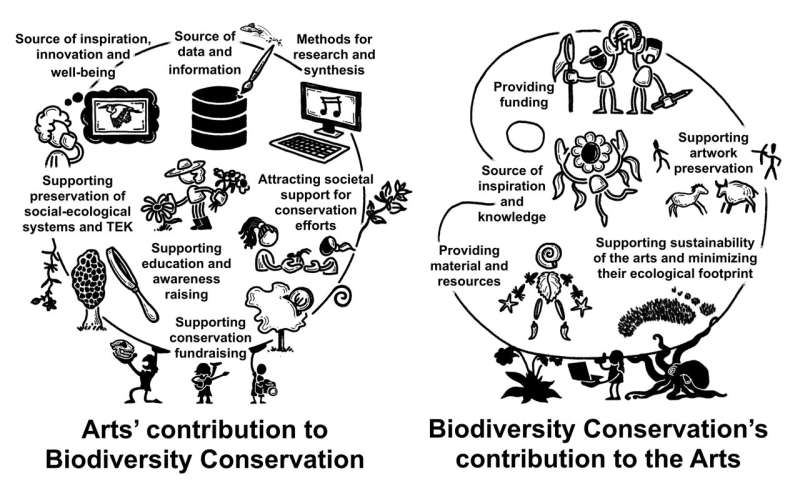Science
Artists and Scientists Unite to Transform Conservation Efforts

A comprehensive study published on November 3, 2025, reveals how collaborations between conservation scientists and artists can significantly enhance efforts to protect nature. The research, conducted by an international team and published in the journal Frontiers in Ecology and the Environment, highlights the potential benefits of merging artistic creativity with scientific rigor to address pressing conservation challenges.
Lead author Ivan Jarić, a researcher from the University of Paris-Saclay in France and the Czech Academy of Sciences, emphasized the importance of these partnerships. “These collaborations can generate new knowledge, attract funding, boost visibility, and even catalyze behavioral change,” he stated. By uniting their expertise, artists and conservationists can co-create innovative solutions that may lead to more effective conservation strategies.
The role of the arts in conservation extends beyond mere inspiration. Artists provide fresh perspectives, stimulate innovation, and enhance public engagement. They can also play a vital role in scientific communication, education, marketing, and fundraising, helping to shape public attitudes toward environmental issues. In turn, conservation efforts can support artists by providing access to expert knowledge, scientific data, and sustainable materials.
Despite the growing interest in arts and conservation collaborations, significant challenges persist. Limited funding, institutional resistance, and misconceptions about the scientific validity of artistic methods often hinder progress. Additionally, the emergence of generative AI presents new ethical complexities that necessitate open dialogue and a shared commitment to transparency among collaborators.
The study’s co-author, Christina Lux from the University of California, Merced, cautioned against potential misrepresentations of biodiversity through art. “To avoid these pitfalls, we stress the need for respectful, reciprocal partnerships that recognize artists as equal contributors—not just as tools for outreach or fundraising,” she noted. Lux argues that conservationists must advocate for collaborations that honor the insights and diversity that art can offer.
Enhancing the synergy between the arts and conservation will require increased funding, institutional support, and a recognition of the unique contributions artists can make. Developing a shared language and evaluation tools to assess these partnerships will also be essential. Conservationists, committed to public engagement and social action, are well-equipped to work alongside artists in these efforts.
Stephanie Januchowski-Hartley from Florida International University urged academic and conservation institutions to create opportunities for collaboration, such as artist-in-residence programs and integrated interdisciplinary initiatives. “Ultimately, deeper synergies between artists and conservationists can lead to broader public support—benefiting not just conservation and the arts, but the health of the planet as a whole,” she concluded.
As the intersections of art and science continue to evolve, the potential for innovative solutions to longstanding environmental issues grows. The collaborative efforts outlined in this study could pave the way for transformative approaches to conservation that engage diverse audiences and foster a deeper appreciation of the natural world.
-

 Technology4 months ago
Technology4 months agoDiscover the Top 10 Calorie Counting Apps of 2025
-

 Health2 months ago
Health2 months agoBella Hadid Shares Health Update After Treatment for Lyme Disease
-

 Health3 months ago
Health3 months agoErin Bates Shares Recovery Update Following Sepsis Complications
-

 Technology3 weeks ago
Technology3 weeks agoDiscover 2025’s Top GPUs for Exceptional 4K Gaming Performance
-

 Technology2 months ago
Technology2 months agoElectric Moto Influencer Surronster Arrested in Tijuana
-

 Technology4 months ago
Technology4 months agoDiscover How to Reverse Image Search Using ChatGPT Effortlessly
-

 Technology4 months ago
Technology4 months agoMeta Initiates $60B AI Data Center Expansion, Starting in Ohio
-

 Technology4 months ago
Technology4 months agoRecovering a Suspended TikTok Account: A Step-by-Step Guide
-

 Health4 months ago
Health4 months agoTested: Rab Firewall Mountain Jacket Survives Harsh Conditions
-

 Lifestyle4 months ago
Lifestyle4 months agoBelton Family Reunites After Daughter Survives Hill Country Floods
-

 Technology3 months ago
Technology3 months agoUncovering the Top Five Most Challenging Motorcycles to Ride
-

 Technology4 weeks ago
Technology4 weeks agoDiscover the Best Wireless Earbuds for Every Lifestyle









